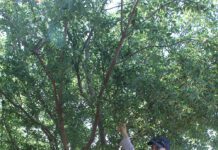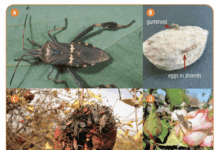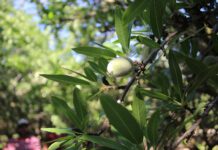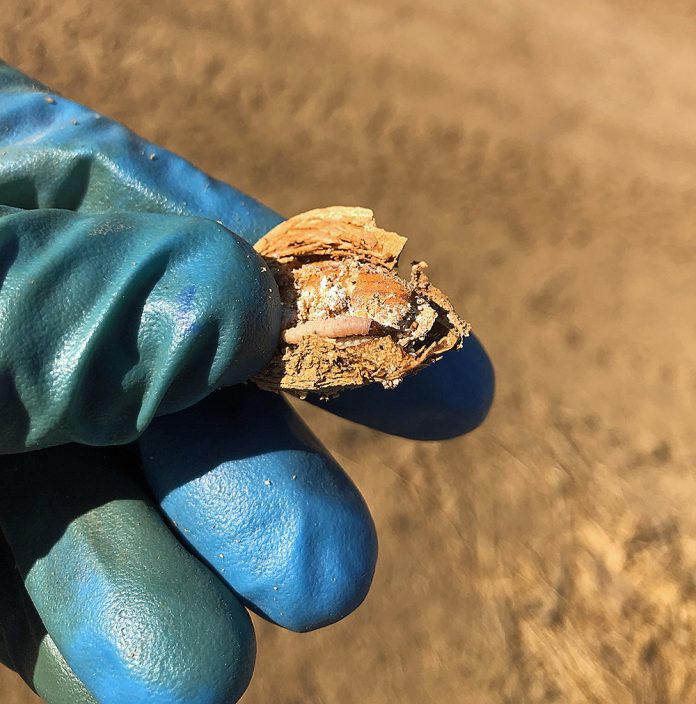
Lack of winter sanitation, a drawn-out hull split that complicated spray timing, abandoned orchards and cost cutting conspired to create the perfect storm for navel orangeworm (NOW) damage in almonds this season.
As a result, many growers and PCAs experienced NOW rejects at least double and frequently many times more than what they usually have.
To reduce the risk of another train wreck happening in 2024, growers need to take an integrated approach to NOW management beginning with winter sanitation, said Mel Machado, Blue Diamond Growers vice president of member relations.
“We’ve got to drop the inoculum (the number of moths out there), and the number of larvae out there has to be reduced,” he said. “It starts with sanitation, that’s the foundation.”
Other components of an integrated program should include timely hull split sprays, obtaining good spray coverage with ample water volume and applying material to every row, mating disruption and a timely harvest, said UCCE orchard and integrated pest management advisors.
Machado described the NOW situation in 2023 as “horrible.” The Northern San Joaquin Valley (Stanislaus, San Joaquin and Merced counties) had reject levels about twice as bad as last year on average. In the Sacramento Valley and a region from Madera south to Kern County, reject levels were averaging three to four times worse than 2022, he said.
“It’s not unusual to see loads come in at 5% or more rejects, and growers who have never had issues are running 5, 6, 7, 8% rejects, and it’s primarily attributable to NOW,” Machado said.
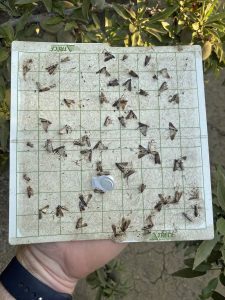
Jhalendra Rijal, UCCE integrated pest management advisor for Merced, Stanislaus and San Joaquin counties, said he had heard reject levels all over the board.
“Some people have 1% to 2%, others 5% to 10% and still others 15% to 20% damage. That’s in our area,” Rijal said.
In the eight years he has served the northern San Joaquin Valley, he said he has never seen NOW damage this severe.
Kevin Hodges, a PCA and CCA with Nutrien Ag Solutions in Fresno, said NOW rejects of 7% to 10% were more common this season than past years in the area he serves from Arvin north to Madera.
“Typically, anything that breaks 3% would warrant a conversation with the grower to make changes to avoid this and could be done fairly reasonably,” he said. “In this challenging environment with pricing issues and cost increases, growers were faced with some tough budgetary decisions this year. In some cases, this meant routine practices such as winter shakes and dormant sprays were cut from their programs. These issues coupled with strong persisting (NOW) populations created a perfect storm, which unfortunately led to an imperfect outcome.”
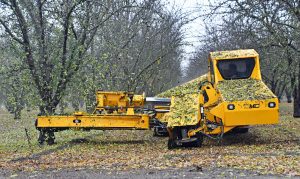
The Almond Board of California recommends keeping NOW rejects below 2% and striving for 1% or less. Not only does the damage reduce overall nut quality, yields and grower payments, but it also opens the door to Aspergillus mold infections and the aflatoxin it produces.
Several export markets have classified aflatoxin as a carcinogen and mutagen. The EU, for example, has set a maximum threshold for aflatoxin B1, the most toxic form, of 8 parts per billion in ready-to-eat almonds.
Lack of Winter Sanitation Hurt
Kern County farm advisor David Haviland said he wasn’t surprised by the high NOW reject levels this season because growers generally conducted less winter sanitation than normal.
“That increased the risk,” he said. “We know prices were down, so people did the minimum amount they could.”
Although the south San Joaquin Valley received near-record rains, it wasn’t nearly the overall amount as regions to the north. In addition, much of the south valley orchard ground comprises sandy soils, allowing for fast drainage.
Most growers who wanted to shake mummies as part of winter sanitation were able to do so, but Haviland said many didn’t to reduce costs.
Because NOW moths can fly significant distances, Hodges said even many of his growers who took integrated approaches still had high reject levels as the pest migrated in from less-managed orchards. He also pointed to so-called “abandoned” orchards, some of which were let go during the prolonged drought. Until those trees are removed and chipped, Hodges said they will continue to be a liability.
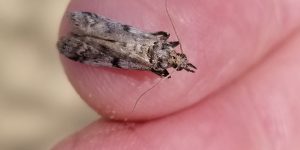
In the northern San Joaquin Valley, Rijal said the extensive rains also prevented many growers from conducting winter shakes to remove mummies. The leftover nuts provided overwintering sites for larvae, and they emerged as moths in the spring. This flight is generally referred to as the first NOW flight.
The mummies also served as egg-laying sites for the first-flight moths. This allowed the population to build, creating an even larger second flight that generally starts around late June-early July. This year, about the first half of the second-flight moths also recycled the mummies and laid eggs on them because of the later-than-normal hull split.
Growers had a situation where moths emerged from the mummies and new-crop nuts at the same time, resulting in a huge population boost in subsequent NOW generations, Rijal said.
He said some growers who weren’t able to conduct winter sanitation turned to a May pesticide application, sometimes called a mummy spray, to try to reduce NOW populations. Both he and Haviland recommend against a May spray because conceptually it doesn’t appear effective. When hull split time comes, the abundance and movement of NOW among orchards becomes so common that killing a few insects in May likely won’t make any difference, at least economically, Rijal said.
Tree Phenology Played a Role
In Kern County, Haviland said it wasn’t just a lack of winter sanitation that contributed to the NOW issue. A cooler-than-normal growing season resulted in an extended hull split as well as a longer harvest, worsening the problem.
Because of slower degree-day accumulation, hull split was about two weeks later than normal and was less synchronized, both of which made hull split spray timing more difficult, he said.
In the south San Joaquin Valley, Haviland said, almond growers typically make their first hull split spray around the Fourth of July. This year, cool weather delayed that until at least mid-July.
Then the question arose about a second spray, which is typically applied two weeks after the first. This year, that timing would have put growers into August.
Because the region typically begins harvest in early August, he said many growers decided against the second spray. Weather-related delays carried into harvest as nut moisture levels were slow to drop.
“Some of those trees sat out there for three or four weeks under high NOW pressure because the crop was delayed,” Haviland said. “And there were trees that were probably out there for four to weeks since the last NOW spray before they got shaken, so the residuals were worn off.”
For example, he said, Nonpareils this season were exposed to both the second and third flights instead of just the second flight in a typical year. Pollinizers this season were exposed to both the third and fourth flights.
“The biggest problem is when the worms get into the nuts,” Haviland said. “If those nuts can be removed from the orchard before the [larvae] become adults, it prevents reinfestation and decreases the subsequent flight.”
This year, the second generation of NOW emerged from Nonpareils and became a large third flight, infecting the nuts before they could be shaken. A similar scenario played out in the pollinizers, where the third flight reproduced, resulting in a larger fourth flight.
“Basically, a timely harvest didn’t happen, insecticide timings were all messed up and it was hard to figure out, and sanitation was less than optimal,” he said.
Reset the Clock with Winter Sanitation
To help minimize a repeat of the 2023 season, Haviland and Rijal said growers need to begin with a strong winter sanitation program.
“They need to get on top of sanitation this winter, that’s the way to reset the clock,” Haviland said.
Rijal agreed. “Moving forward, winter sanitation needs to be the bottom line because you can’t clean up NOW unless you clean the mummies from the trees, that’s the evidence we saw this year. Then you use other tools during the season.”
In the early 2000s, research by Joel Siegel and Brad Higbee found that reducing the number of mummies to an average of one or fewer per tree paid an economic return for south San Joaquin Valley producers. That was back when labor was significantly less expensive and polling crews were more available.
In light of today’s higher labor costs and less worker availability, Haviland said growers and PCAs may want to reassess mummy counts and consider the thresholds used in the more northern production areas.
In those regions, UCCE recommends scouting at least 20 random trees in a block and counting the number of mummies. The goal is to reduce the average number to two or fewer per tree by February 1.
“If [almond] prices are high and labor costs are low, and accessibility to polling crews is no problem, getting down to one per five trees is a great goal,” Haviland said. “Considering what labor costs are compared to 10 years ago, I would hope everybody would shoot for two per tree. There’s nothing wrong with that number. If you want to do better, great, but you shouldn’t spend $400 per acre to try to do that.”
Hodges agreed, saying winter sanitation and overall NOW management works better when neighbors join to form larger blocks.
“It’s really important that everybody is on the same page in getting control on this together,” he said. “You have to check all the boxes and do this by the book. If you get a number of your neighbors together and everybody is on board and driving these points, then I think everybody in the area can produce a cleaner crop.”
Once the nuts are on the ground after shaking, Hodges said it’s equally important to sweep them into windrows and shred or chop them to destroy overwintering larvae and NOW habitat.



